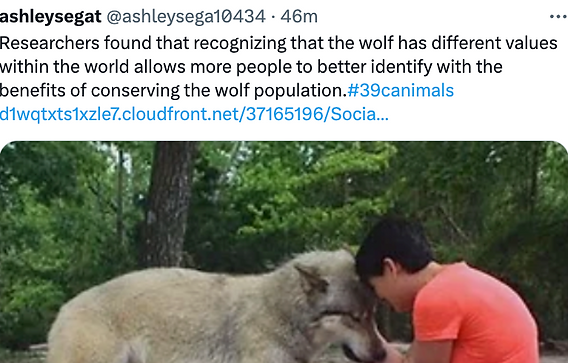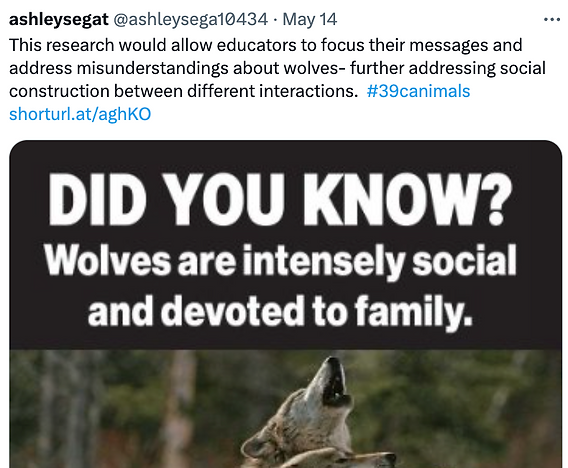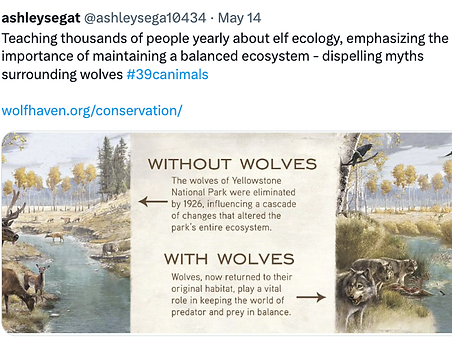A first year Poli-Sci Major
SMC Reflection
Hello fellow viewers! Here will be where I showcase my writing during my research journey and through the Writing 60 course!
What I have learned through the course
We have been working on collecting an array of information on animal projects all over the world. From the beginning I knew that I would want my own research to look at canine species- but I did not know how to approach the research or even how to choose an animal. Between reading my peer’s blog posts and scanning the ends of Twitter on animal research findings, I was able to gain a better understanding of the human relationship with wildlife. For example, in one of the class materials “Wolfs, dogs and us” by Carl Safina, I was given a broad look at the relationship between domesticated dogs and humans and how it differentiated from our relationship with wolves. Safina’s distinction in highlighting individuality amongst wolves was the spark that lit my curiosity for research surrounding wolves. Circling back to the usefulness of social media, I was able to gather a quick and comprehensible understanding of wolf behavior and the dangers they face- including the roles that conservationists and the government play in protecting their lives.
However,
However, Twitter did not only help me solidify my research topic, but also allowed me to practice how to condense the information I was learning in a more comprehensible way. How? By posting on twitter over 10 times a week on the theme of the week. Here are some of my favorite tweets.

Reflection
In order to actually understand the importance of individualizing wolf research, we needed to understand how different they are from dogs. Especially when we are looking to deflate myths made against wolf conservation efforts.

Reflection
This tweet, I connected the readings to the information I was learning- how our own perception of our intelligence affects our perception of other animals. So I highlighted the array of intelligent behaviors wolves exhibit
But there was times where my tweets weren't the absolute best…..

Reflection
At the beginning of class we just needed to have a better basic understanding of the types of species we might want to research on. I found out very quickly I wanted to focus on canines, and wanted to highlight the different levels of cognitive abilities canines had. Although I choose a good research to learn more about this topic, the screenshot from the research does not grab anyone's eyes and my tweet was too broad, not connecting with any type of audience.
Social Media Campaign Project
The SMC is a week-long Twitter assignment designed to help students look more into the problems that their chosen animal face, the organizations that are dedicated to addressing these problems, and some of the solutions experts have made in efforts to protect wildlife. We did this by researching all respective ideas and making twitter posts every day that explained the information we found more useful and important to include. Due to the limited characters given to make a post, students were able to practie how to condense large ideas and make their content more engaging by using an array of rhetorical skills to raise awareness to a broader audience.
Some examples of my twitter posts on the problems wolves face

Reflection
Through my SMC project, I focused on making my post approachable and incorporating the #39canimals in the post. For this specific tweet though, I wanted to highlight the different (larger) issues that the gray wolf faces in order to better contextualize how much information is out there. I ended the tweet by crediting this organization's website as a resource if people do want to learn more.

Reflection
In this tweet, I wanted to include a graphic that demonstrated the decision-making that conservationists face when they work for solutions to protect the lives of wolves. It is important to note that the problems wolves face are human made, and they can only be fixed by human. But in order to understand more about the problems that wolves face out in their habitat, we must learn why these problems still exist.
Some examples of my Twitter posts on wolf conservation solutions

Reflection
I choose to highlight this solution-based research in my project because all the underlying issues that wolves face are due to the detachment between wolves and humans. As a result, it is important to highlight research that has prove the benefits of valuing the wolf in order to strengthen this relationship . By doing so people are more likely going to care and makes it harder for people to ignore the problems they face.

Reflection
Similar to the tweet above, I highlighted a research study that focuses on how educators can best address the misunderstandings about wolves in school, including social construction. I will acknowledge that the best solution is passing legislation that protects the lives of wolves, this cannot happen when people continue to villainize them. This research focuses on the exact myths that must be addressed, and implications for. correcting those misunderstandings
Some examples of my Twitter posts on conservation organizations

Reflection
Biological diversity has been tackling different cases where States within the US have failed to prioritize the lives of wolves, despite their decline in population. Their website breaks down the different lawsuits they have filed in order to protect wolves, talking about their case and the significance of their fight.

Reflection
However, Twitter did not only help me solidify my research topic, but also allowed me to practice how to condense the information I was learning in a more comprehensible way. How? By posting on twitter over 10 times a week on the theme of the week. Here are some of my favorite tweets.